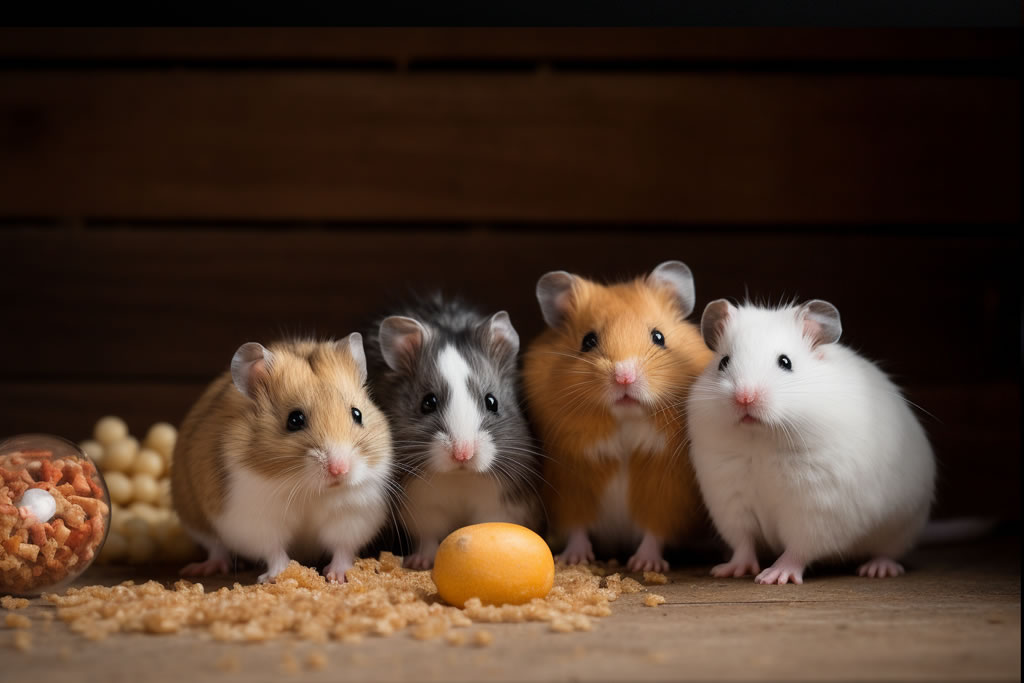Let’s get one thing straight—I didn’t plan on becoming the neighborhood’s “crazy hamster lady.” It started with a Syrian named Toast, then spiraled into a decade-long obsession with these furry potatoes. Through escape artist Robos, grumpy Chinese hammies, and a disastrous attempt at dwarf cohabitation, here’s my no-BS guide to hamster species with actual real-life insights.
The Cast of Characters: Your Pocket Pet Options
(Spoiler: Not All Are Cuddle Bugs)
1. The Golden Child: Syrian Hamsters
Meet: Your classic starter hamster
My Take: “Teddy bear” my foot—Toast once stole my engagement ring
| Trait | Store Brochure Version | Reality Check |
|---|---|---|
| Size | 5-7 inches | Basically a small guinea pig |
| Handling | Great for kids! | Will ninja-leap from 5-year-old’s hands |
| Social Needs | Prefers solitude | Will murder cage mates (RIP Peanut) |
| Cost | 10−10−20 | $200+ vet bill when they eat your AirPod |
Pro Tip: Get a 24” wheel—my long-haired Syrian Mr. Floof got back matting from standard sizes.
2. The Speed Demons: Roborovski Dwarfs
Meet: The hamsters that make you question your reflexes
My Take: Bought a pair, named them Flash & Zoom—saw them 3 times total
Robo Reality vs. Myth
| Expectation | Reality | Survival Tip |
|---|---|---|
| “Playful pets!” | Living room chases at 3AM | Use a kiddie pool for playtime |
| “Low maintenance” | Need Sahara-like sand baths | Buy reptile sand (cheaper at PetCo) |
| “Fun to watch!” | Blink and you’ll miss them | Set up night-vision cam for grandkids |
Confession: I once lost a Robo for 3 days—found him hoarding cat food in the HVAC system.
3. The Moody Artists: Winter White Dwarfs
Meet: Nature’s mood ring
My Take: My Picasso changed from snow white to gray when I moved apartments
Seasonal Color Guide
| Color Phase | Triggers | Owner Panic Level |
|---|---|---|
| Snowball White | <12hrs daylight | “Is this mold?!” |
| Salt & Pepper | Temperature fluctuations | “Google: Hamster turning old” |
| Smoky Gray | Pet store lighting | “Did they switch my hamster?!” |
DIY Hack: Use LED timers to control coat changes—works better than my college sleep schedule.
4. The Identity Crisis Crew: Campbell’s Dwarfs
Meet: The “Wait, is that a Winter White?” species
My Take: Adopted two “Russian dwarfs”—turned out to be Campbells. Chaos ensued.
Campbell’s vs. Winter White: Spot the Difference
| Feature | Campbell’s | Winter White |
|---|---|---|
| Face Shape | Grumpy old man | Disney cartoon |
| Social Tolerance | “I’ll tolerate you” | “I’ll plot your demise” |
| Treat Preference | Will sell soul for mealworms | Suspicious of new foods |
| Vet Bills | Frequent (diabetes-prone) | Moderate |
Lesson Learned: Never trust pet store labels. DNA test cost more than the hamsters.
5. The Oddballs: Chinese Hamsters
Meet: The “rat hamster” that’s actually awesome
My Take: My Zipper escaped weekly—taught himself to tightrope walk curtain cords
Chinese Hamster Quirks
| Trait | Perceived Issue | Silver Lining |
|---|---|---|
| Rat-like tail | “Ew, creepy!” | Great for balance during acrobatics |
| Solitary nature | “Anti-social” | Won’t eat cage mates |
| Vertical agility | Escape risk | Free circus entertainment |
Habitat Hack: Use bird cage liners—their climbing skills defy all hamster-proofing.
The Real Cost of Hamster Parenthood
(They Don’t Tell You This at PetSmart)
First-Year Expenses Breakdown
| Item | Pet Store Price | Smart Shopper Hack | Reality Cost |
|---|---|---|---|
| Cage | $89.99 | Use a 50-gallon sterilite bin | $25 |
| Wheel | $34.99 | Repurpose a vintage record | Free (squeaky AF) |
| Vet Fund | “Hamsters don’t need vets!” | ER visit for wet tail | $300+ |
| Sleep | N/A | Earplugs for night wheel runs | Priceless |
Species-Specific Survival Guide
Handling Cheat Sheet
| Species | Best Approach | Never Ever |
|---|---|---|
| Syrian | Palm surfing with treats | Wake them abruptly |
| Roborovski | Observe from afar | Attempt daytime cuddles |
| Chinese | Shoulder rides | Leave cage door unlatched |
| Dwarf Groups | Mediator training | Assume they’ll get along forever |
FAQ from a Decade in the Trenches
Q: Can I keep two Syrians together if they’re siblings?
A: Only if you want a hamster version of Game of Thrones.
Q: Do Roborovskis ever slow down?
A: Yes—when they’re plotting their next great escape.
Q: Why does my Chinese hamster stare into my soul?
A: He’s calculating how to reach your ceiling fan.
Q: Are colorful hamster foods safe?
A: About as safe as a TikTok diet trend. Stick to natural mixes.
Final Thoughts: Choose Your Adventure
After 14 hamsters (yes, I’m counting the great HVAC rescue), here’s my hard-won wisdom:
- First-timers: Go Syrian or Chinese—they’re the golden retrievers of hamsters
- Night owls: Robos will match your 2AM energy
- Control freaks: Winter Whites’ color changes keep you humble
- Gamblers: Try dwarf pairs (but keep bandaids handy)



